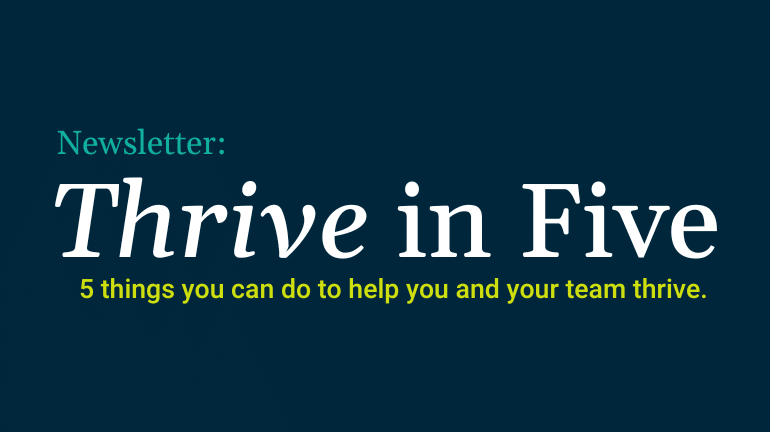Thrive in Five Newsletter: Strategic Workforce Development for Federal Leaders

The federal workforce is in the midst of a fundamental transformation. While headlines focus on budget constraints and workforce reductions, the real leadership challenge isn’t simply doing more with less — it’s strategically building capability while maintaining mission delivery under pressure.
Budget cuts, hiring freezes, and shifting priorities happen whether we’re ready or not. But what we’ve learned from organizations that navigate these challenges successfully is that they focus their energy on what they can control. Rather than waiting for external conditions to improve or perfect solutions to emerge, they leverage what they already have — their people, their existing resources, and their operational knowledge — to build internal capacity.
This shift in focus changes everything. The question isn’t whether to invest in workforce development, but how to implement strategic upskilling approaches that deliver immediate impact while creating sustainable pathways for continuous improvement. This month’s resources offer a practical roadmap for exactly that: transforming workforce constraints into catalysts for sustainable change.
1. Deploy Internal Resources to Bridge Mission-Critical Skills Gaps
Federal agencies are navigating an unprecedented workforce landscape where evolving priorities and leaner staffing create are exposing critical skills gaps that threaten mission delivery. Agencies are challenged to build future-ready capabilities while managing today’s immediate constraints. Teams that fail to address these gaps proactively face cascading operational risks that extend far beyond internal challenges.
Bridging the Skills Gap: A 90-Day Framework to Upskill Your Team >>
Upskilling doesn’t have to wait for perfect conditions. This playbook, developed by Evans subject matter experts Shashuana Littlejohn, Rasha Fakhreddine, and Mercedes Sotomayor, provides a structured, implementation-focused framework for upskilling federal teams within existing constraints. Designed for rapid deployment, the 90-day approach jumpstarts momentum while building sustainable learning ecosystems. Rather than relying on external hires or costly training programs, this approach builds internal capacity by assessing, prioritizing, and deploying existing personnel while embedding continuous learning into the organization’s core operations.
2. Focus Development Resources on Tomorrow’s Mission-Critical Skills
Federal leaders need current, evidence-based frameworks for identifying which skills matter most in today’s rapidly evolving work environment. Generic competency models often miss emerging capabilities that distinguish high-performing teams from those struggling to adapt. The challenge is focusing limited development resources on skills that will deliver the greatest operational impact while building long-term organizational resilience.
10 Emerging Skills For Professionals >>
This article provides federal HR professionals with practical guidance for skill-building approaches that agencies can implement internally without external training dependencies. Rather than offering abstract competency lists, it connects specific capabilities to workplace performance outcomes and provides actionable development strategies that integrate with existing organizational structures and processes.
3. Map Existing Skills to Tomorrow’s Mission-Critical Needs
Federal agencies implementing upskilling initiatives often struggle with systematic approaches that connect current workforce capabilities to future mission requirements. Without structured planning, even well-intentioned development efforts can miss critical skill gaps or fail to align with strategic priorities.
OPM Workforce Planning Guide >>
The OPM Workforce Planning Model guides agencies through critical steps including workforce analysis, gap identification, solution development, and implementation planning that directly support upskilling initiatives. Rather than ad hoc training approaches, this model ensures development efforts are strategically targeted to address specific organizational needs while considering factors like succession planning, knowledge transfer, and resource optimization. This is particularly valuable for agencies implementing the 90-day upskilling approach, as it provides the analytical foundation needed to prioritize training investments and measure their strategic impact.
4. Build AI Literacy at Scale Using Government-Approved Tools
As artificial intelligence rapidly transforms how work gets done, federal agencies face the dual challenge of building AI literacy across their workforce while ensuring secure, compliant implementation. The gap between AI’s potential and actual workforce capability creates both operational risks and missed opportunities for efficiency gains. Agencies need accessible, secure platforms that enable both experimentation and systematic skill development.
GSA’s USAi platform, launched in August 2025, provides federal agencies with no-cost access to secure generative AI tools for workforce upskilling and practical experimentation. The platform includes usage analytics and dashboards that enable agencies to track adoption and measure impact systematically. This tool directly addresses the technology training component essential for modern workforce development while supporting agency-level digital transformation initiatives. USAi offers a practical pathway for building AI literacy at scale without the security concerns or procurement challenges that typically slow federal adoption of emerging technologies.
5. Standardize Upskilling Efforts Using Government-Wide Workforce Frameworks
Federal agencies implementing upskilling initiatives often struggle with inconsistent skills definitions and assessment criteria across different roles and departments. Without standardized frameworks for identifying and measuring competencies, even well-intentioned development efforts can miss the mark or fail to align with broader government workforce strategies. This gap between agency-specific training and government-wide career progression creates barriers for both employee development and organizational capability building.
OPM Handbook: Skills-Based Job Qualifications for Governmentwide Roles >>
The OPM handbook provides federal agencies with standardized, skills-based job qualifications that can be applied across government roles. This resource directly supports the assessment and prioritization phases of workforce development by offering consistent frameworks for identifying critical competencies and measuring skill gaps. Rather than creating assessment tools from scratch, agencies can leverage these government-wide standards to ensure their upskilling efforts align with broader federal workforce strategies and career progression pathways.
Consider these questions as you plan your upskilling approach:
- What specific emerging skills will drive the greatest mission impact in your current operational context?
- How can you combine structured frameworks with proven learning methods to maximize stretch your existing resources further?
- How might you coordinate these development efforts to build both individual capabilities and organizational resilience?
Change is complex, but it’s also manageable when guided by clarity, structure, and genuine attention to how people learn and grow. The path forward is about making strategic choices that meet today’s operational needs while building tomorrow’s capabilities. Your teams have more potential than current constraints might suggest. The question is: how will you unlock it?

